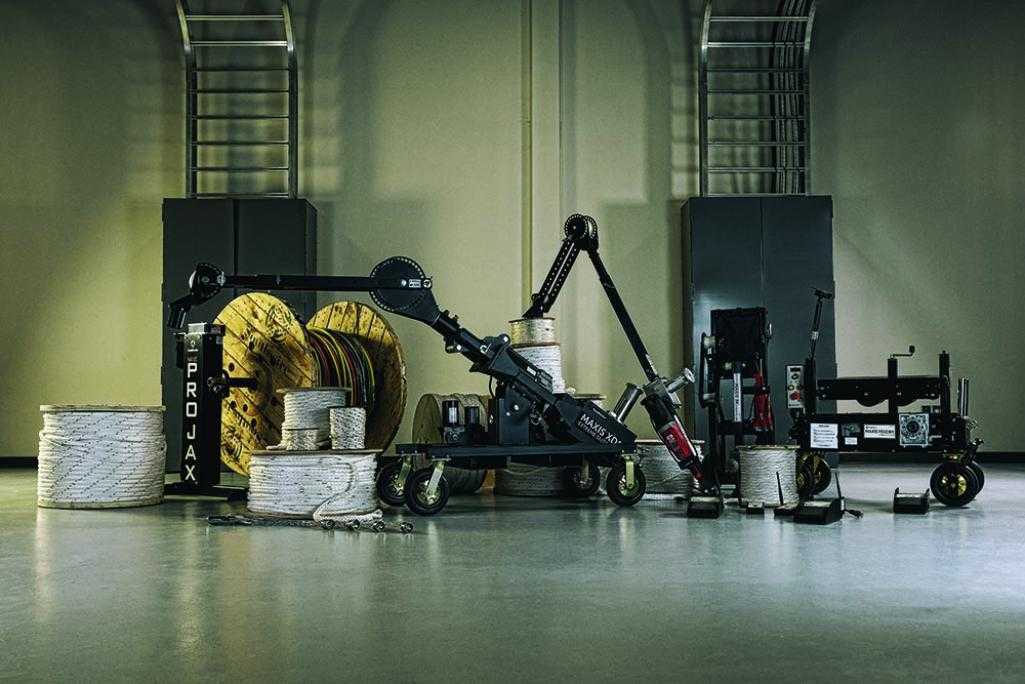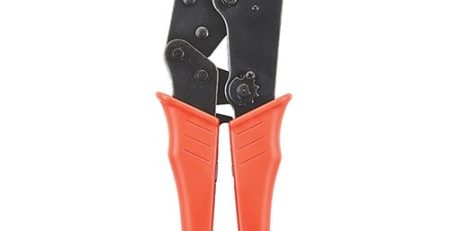Cable Pullers 1
Cable Pullers
Pulling cable through conduit is a basic task in electrical work. While manual cable pullers are available and still used, most commercial jobs use electric-powered pullers with pulling forces up to 10,000 pounds.
Recent improvements to electric cable pulling and support equipment—as well as accessories that expedite the pulling process—make the work easier and faster, ultimately increasing the number of pulls in a work day.
Following, three manufacturers discuss their latest pulling accessories, the most widely used accessories and safe operation.
Greenlee, Rockford, Ill., offers a variety of cable pullers with maximum pull capacities of 2,000, 6,000, 8,000 and 10,000 pounds, said Jae Lee, product manager. The company’s 6,000-pound G6 Turbo cable puller was a NECA Showstopper winner at the 2017 NECA Convention and Trade Show in Seattle.
“This puller is designed with no loose pieces and eliminates the need for conduit adapters,” Lee said. “The motor is specifically designed for 6,000-pound cable pulls to provide continuous cable pulling force and fast pulling speed. A dual-capstan design with two-speed motor provides four speed options, allowing operators to adjust the cable-pulling speed to their comfort level.”
Greenlee recommends powered pulling equipment—designed specifically for cable pulling—over manual pullers.
“Pulling cable manually increases the risk of injury as well as damaging the cables,” Lee said. “The selection of powered pullers available allows electrical contractors to select the appropriate puller for each job.”
Pulling rope is a critical element in making successful cable pulls.
Cable Pullers
“We offer double-braided composite ropes between 3/8- to 7/8-inch in diameter in three different lengths: 300, 600 and 1,200 feet,” Lee said. “Each rope’s diameter has a maximum rated capacity ranging between 1,200–8,000 pounds. Rope should meet or exceed the cable puller’s maximum pulling force. All of our pulling ropes feature factory-spliced eyes at both ends.”
According to Lee, accessories that expedite pulling include cable-pulling boom systems, reel stands, cable feeders, real-time pulling force equipment, cable grips, pulling rope, sheaves and additional accessories. Together, these provide a complete cable-pulling solution for electrical contractors.
“There are cable feeders that can help feed multiple cables at the same time,” Lee said. “This can help keep electricians from manually unspooling cable and reduces the pulling force. A variety of cable grips ensures electricians that the cable is securely connected to the pulling rope. These grips are easy to use and reduce the cable-pull-setup time. Some cable grips can be used to help electricians pull more cable to get more tail cable length. When pulling traditional insulated electrical cables, lubricants should always be used. Lubricants decrease the friction during a cable pull, which reduces the pulling force and potential of damaging the cable insulation.”
A force gauge helps accurately monitor cable-pull force and protect the cable from exceeding the maximum rated pull strength. A force gauge is different than a force indicator because it shows the total pull distance and cable pull speed in addition to the live pull fore data. It also saves the pull data to share with engineers and inspectors.
David Jordan, president of iTOOLco, Oak Ridge, Tenn., said the decision whether to use a manual or electric Cable Puller depends on safety.
“A power puller should be used in any situation where the pull exceeds the pulling strength of an individual for any extended period of time,” Jordan said. “Typically, anytime a pulling load exceeds 80 pounds of pulling force, a powered equipment puller is recommended.”
iTOOLco offers 110-volt (V) electrical wire pullers with 6,000 and 10,000 pounds of pulling force. Both are equipped with four-speed dual capstans.
Recent updates to the 6,000-pound wire puller include a 30-inch extension for longer reach, convenient foot switch holder and extension storage cradle.
Jordan said updates to the 10,000-pound model include two extra 15- and 33-inch extensions to allow for longer reach, providing up to 13 feet of wire from conduit opening to capstan, larger front knuckle with profiled phenolic resin roller, swiveling rear casters for easy job-site movement and precise conduit positioning, an extra receiver hitch adapter for occasions when bolting the wire puller to the floor is necessary, convenient foot switch holder and extension storage cradle.
“While our Cable Pullers work with any pulling rope, safe and efficient wire pulls are reliant on durable rope with stable tensile strength,” Jordan said. “We recommend using a high-performance synthetic fiber rope. Our Pull Slick Rope has a tensile strength of 39,000 pounds, is stronger than steel, has 25 percent reduction in coefficient of friction, and it is two-thirds the weight of traditional pulling ropes. In addition, it does not absorb water, will not rot and resists abrasion.”
Regarding lubricants, Jordan said most cable manufacturers offer no-lube wire, which studies have shown works best for all pulling applications. When not using conductors with pre-installed lubricant or a no-lube wire, lubricants always will aid in the wire pull.
Jordan cited tools that are available to enhance the performance of wire pullers and increase the efficiency of wire pulls.
“Lock-in-place conduit sheaves can be locked into place overhead or at any angle for safer wire pulls,” he said. “Multi-rollers or radius rollers eliminate the need for extra rigging with adjustable picking arms that permit easy fine-tuning the adjustment angle. A 90-degree tray roller can create a closed roller guide that ‘traps’ conductors to reduce the risk of job site injuries.”
Allan Daniel, contractor equipment product manager, Southwire Tools and Equipment, Carrollton, Ga., recommends power-pulling equipment be used when pulling forces exceed 50 pounds. The most important features to consider when comparing equipment are pulling speed, adaptability, peak and continuous duty pulling force, and amp draw.
“Southwire offers a full line of pulling ropes, including both low-stretch and traditional double-braided ropes in a variety of sizes,” Daniel said. “Southwire also offers other cable-pulling accessories, [including] Maxis Grips to reduce setup time. [Another example is] SIMpull heads, which now are available attached or unattached. Factory-attached SIMpull heads are guaranteed to exceed the maximum allowable pulling force. Unattached SIMpull heads are now available for contractor installation. Southwire’s hands-free SIMpull Cable Guide System enhances operator safety and protects the cable from damage. The Maxis Feeder reduces back-tension during pulls and can be used to remove old cable from conduit.”
Pulling Cable Safely
Jae Lee, product manager, Greenlee, said cable pulling can be a very dangerous task, and the first priority when selecting a Cable Puller should be providing safety for the electrician using it.
“Always use a puller with the appropriate continuous-pull-force rating,” he said.
Maximum pull force represents the maximum pulling force at a short duration of time. Continuous pull force is the amount of force the Cable Puller can continuously pull over a long period time. Continuous pull force rating ensures the puller’s motor will not burn up during the pull.
“Additionally, a force indicator can monitor cable pull force, which an operator can use to determine when to adjust the pulling speed,” Lee said. “Another key feature is the antireverse feature on the motor, which prevents a puller from losing tension of the rope when the cable pull stops while in operation.”
It always is dangerous to stand directly behind the puller and the rope coming out of the conduit.
“It is important for the operator to stand to the side of the puller,” Lee said. “Greenlee pullers are designed with a 90-degree roller that changes the direction of the rope from capstan allowing operators to stand to the side of the puller. In addition, the use of a foot switch prevents electricians from having to position themselves directly behind the rope or puller when turning the puller on and off.”
David Jordan, president of iTOOLco, said one of the biggest workplace concerns—and the main reason iTOOLco was established—is to improve job-site safety for contractors and the professionals they employ.
“Traditional bolt-down Cable Pullers can rip from the floor if the anchors are not properly sized for the load,” he said. “iTOOLco wire pullers never run the risk of improper sizing because they mount safely to the conduit system. Traditional bolt-down Cable Pullers, which typically weigh 60-plus pounds, require two people to safely move them into position for anchoring. That’s why we designed 10,000- and 6,000-pound pullers with wheels, a counter balanced wheel base, and a maximum working weight of 15 pounds. One person can maneuver these Cable Pullers around the job-site safely.”
Jordan offered other safety guidelines, including the following: Always isolate or disconnect any live voltage, situational awareness is a key to being safe, properly set up equipment, do not use old or damaged equipment, and consult the manufacturer if questions about equipment setup arise.
Cable Pullers ElSewedy cables prices 2022
ElSewedy cables prices 2022
We are pleased to have you visit our pages on social networking sites, where we publish exclusive offers on our website.
Our Facebook page here .
Our Twitter account is here .









Leave a Reply
You must be logged in to post a comment.